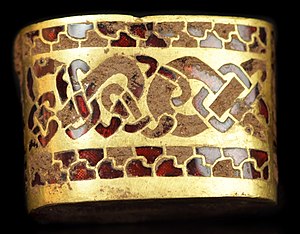
Back Stæffordscīr hord ANG Стафардшырскі скарб Byelorussian Tresor de Staffordshire Catalan Staffordshireskatten Danish Schatz von Staffordshire German Trezoro de Staffordshire Esperanto Trésor du Staffordshire French Skat fan Staffordshire Frisian Trezoro de Staffordshire IO Staffordskírissjóðurinn Icelandic
| Staffordshire Hoard | |
|---|---|
 | |
 | |
| Material |
|
| Size | over 3,500 items |
| Writing | Latin |
| Created | c. 7th to 8th centuries |
| Discovered | 2009 Hammerwich near Lichfield, Staffordshire, England 52°39′19″N 1°54′24″W / 52.65528°N 1.90667°W |
| Discovered by | Terry Herbert |
| Present location | |
The Staffordshire Hoard is the largest hoard of Anglo-Saxon gold and silver metalwork yet found[update]. It consists of almost 4,600 items and metal fragments, amounting to a total of 5.1 kg (11 lb) of gold, 1.4 kg (3 lb) of silver and some 3,500 pieces of garnet cloisonné jewellery.[1] It is described by the historian Cat Jarman as "possibly the finest collection of early medieval artefacts ever discovered".[2]
The hoard was most likely deposited between 650 and 675 CE, and contains artefacts probably manufactured during the 6th and 7th centuries.[3] It was discovered in 2009 in a field near the village of Hammerwich, near Lichfield, in Staffordshire, England. The location was in the Anglo-Saxon kingdom of Mercia at the time of the hoard's deposition.
The hoard is of "radical" importance in Anglo-Saxon archaeology.[4][5] The artefacts are nearly all martial in character and contain no objects specific to use by women.[6][7]: 9 The average quality of the workmanship is extremely high and especially remarkable in view of the large number of individual objects, such as swords and a helmet, from which many of the fragments in the hoard came.
The hoard was purchased jointly by the Birmingham Museum and Art Gallery and the Potteries Museum & Art Gallery for £3.285 million under the Treasure Act 1996.
- ^ Alexander, Caroline (November 2011). "Magical mystery treasure". National Geographic Magazine. Vol. 220, no. 5. p. 44. Archived from the original on 25 December 2016. Retrieved 31 October 2011.
- ^ Jarman, Cat (2021). River Kings: The Vikings from Scandinavia to the Silk Roads. London: William Collins. p. 174. ISBN 978-0-00-835311-7.
- ^ Cool, Hilary (Winter 2015–2016). "The Staffordshire Hoard". Historic England Research News. No. 2. Historic England.
- ^
"The Staffordshire Hoard: Comments sent to us". Archived from the original on 28 September 2009. Retrieved 24 September 2009.
absolutely the metalwork equivalent of finding a new Lindisfarne Gospels or Book of Kells ... this is going to alter our perceptions of Anglo-Saxon England as radically, if not more so, than the Sutton Hoo discoveries.
- ^
"Anglo-Saxon gold: Largest-ever hoard officially declared treasure". The Daily Telegraph. London. 24 September 2009. Retrieved 24 September 2009.
It is a fantastically important discovery. It is assumed that the items were buried by their owners at a time of danger with the intention of later coming back and recovering them.
- ^ "The Find". Staffordshire Hoard (staffordshirehoard.org.uk). Archived from the original on 3 July 2011. Retrieved 14 June 2011.
- ^ Cite error: The named reference
Leahy-Bland-2009was invoked but never defined (see the help page).
© MMXXIII Rich X Search. We shall prevail. All rights reserved. Rich X Search